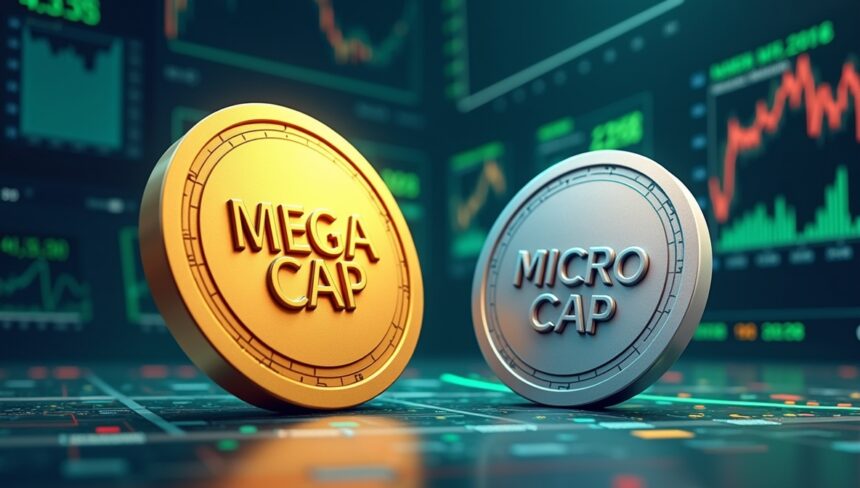I will discuss the Mega-cap vs Micro-cap Tokens, articulating their principal divergences, the risks and rewards they embody, and their respective roles within the cryptocurrency ecosystem.
Tokens of the mega-cap class, typified by Bitcoin and Ethereum, provide relative stability and a pronounced degree of trust among market participants; conversely, micro-cap tokens exhibit elevated volatility, presenting investors with correspondingly pronounced levels of risk and potential for outsized reward. A comprehensive understanding of both token classes is necessary for the construction of informed, strategically balanced portfolios.
What Are Mega-cap Tokens?
Mega-cap tokens refer to cryptocurrencies possessing the largest market capitalizations, generally surpassing the threshold of $200 billion, and thus forming the pivotal layer of the digital asset ecosystem. Bitcoin and Ethereum epitomize this category, benefitting from extensive adoption, high liquidity, and universal brand recognition.

Their capital flows exhibit comparatively subdued volatility relative to lower-tier assets, rendering them appealing to institutional investors and patient capital. As quasi-benchmarks, these tokens frequently guide broader sector price discovery and shape prevailing market sentiment. Although the risk profile associated with mega-cap assets is diminished, commensurately modest growth prospects are reflected in prevailing valuation multiples.
What Are Micro-cap Tokens?
Micro-cap tokens refer to cryptocurrencies whose total market value typically falls below the $50 million threshold, characterizing them as highly speculative investments.

These digital assets are generally associated with emergent or under-the-radar initiatives seeking to advance specialized use cases within the broader blockchain and decentralized finance (DeFi) ecosystems.
Given their nominal starting prices, micro-cap tokens promise considerable upside appreciation; however, they also harbor correspondingly substantial vulnerabilities, including restricted trading volume, acute price fluctuation, and heightened exposure to fraudulent schemes.
Consequently, market participants tend to classify these instruments as high-risk, high-reward alternatives relative to more established mega-cap tokens.
Key Differences Between Mega-cap and Micro-cap Tokens
| Feature | Mega-cap Tokens | Micro-cap Tokens |
|---|---|---|
| Market Capitalization | Above $200 billion (e.g., Bitcoin, Ethereum) | Below $50 million (emerging projects) |
| Liquidity | Very high, easy to trade | Low, harder to buy/sell large amounts |
| Volatility | Relatively stable compared to smaller caps | Extremely volatile with sharp price swings |
| Risk Level | Lower risk, more secure investments | High risk, prone to scams and failures |
| Growth Potential | Moderate, steady long-term returns | High, with chances of explosive gains or losses |
| Investor Type | Institutional investors, long-term holders | Speculators, risk-tolerant retail investors |
| Adoption | Widely accepted, strong ecosystem support | Limited adoption, early development stages |
Which Should You Choose?
pt for Mega-cap Tokens if:
- You prioritize long-term security and capital preservation.
- You require a liquid position and a smoother price curve.
- You seek reliable growth with controlled drawdowns.
Opt for Micro-cap Tokens if:
- You accept elevated risk in pursuit of outsized appreciation.
- You prefer access to nascent, potentially disruptive projects.
- You can withstand sharp price swings and a possible loss of principal.
Risks and Rewards
Risks
Mega-cap Tokens: While generally lower risk, exposure remains to macroeconomic factors, the potential for sudden regulatory shifts, and broader market corrections.
Micro-cap Tokens: These tokens exhibit the most pronounced risk profile: irregular market depth, severe price swings, exploitative schemes, and unclear project longevity collectively amplify the danger.
Rewards
Mega-cap Tokens: Characterised by relative price stability, predictable yield, and extensive adoption proven by institutions and the market, rendering them predictable.
Micro-cap Tokens: Capable of dramatic appreciation; a small fraction that secures market acceptance may realise multipliers that justify the speculative nature of the assets.
Future Outlook
The forward-looking trajectory for mega-cap and micro-cap tokens illustrates divergent roles within the ongoing maturation of the cryptocurrency ecosystem. Mega-cap assets will likely sustain their primacy, underpinning broad-based adoption, attracting institutional capital, and steering the formation of coherent regulatory architectures.
Their relative stability, coupled with already widespread international recognition, serves to institutionalize them as durable digital assets—comparable in function and durability to established blue-chip equities.
In contrast, micro-cap tokens will persist as laboratories of innovation, trialing cutting-edge protocols, pioneering decentralized finance architectures, and catering to narrowly defined sectors of demand.
Predicted attrition will be pronounced, but a limited cohort of survivors could conceivably ascend to the ranks of major market currencies, thereby presenting potentially outsized returns to judicious, early-phase backers.
Pros & Cons Mega-cap vs Micro-cap Tokens
Pros & Cons Mega-cap Tokens
Pros:
- High liquidity; orders fill quickly without market impact.
- Lower volatility; price swings are smaller than smaller-market counterparts.
- Established global adoption; widespread trust among market participants.
- Long-term historical stability; appropriate for conservative investment profiles.
Cons:
- Growth potential is muted; upside is capped rather than explosive.
- Elevated relative valuation; full-entry price can be prohibitive for smaller accounts.
- Subject to cyclical downturns and emerging regulatory scrutiny.
- Vulnerable to macroeconomic factors; price does not move independently.
Pros & Cons Mega-cap Tokens Micro-cap Tokens
Pros:
- Enormous relative upside; even small market-cap increases can yield substantial percentage gains.
- Early access to pioneering projects; investors can buy before widespread awareness.
- Some assets exhibit parabolic price trajectories; returns may exceed 10x.
- Drives portfolio diversification; benefits investors with high risk appetite.
Cons:
- Extreme price volatility; swings of 20-50% over days are common.
- Shallow order books; executing orders of significant size can move market price radically.
- Elevated risk of fraud; exploits such as rug pulls and abandoned projects are frequent.
- Questionable durability; few micro-caps sustain relevance for more than twelve months.
Conclusion
Mega-cap and micro-cap cryptographic tokens illustrate divergent evolutionary models within the digital-assets ecosystem. Large-cap assets, typified by Bitcoin and Ethereum, confer institutional-grade liquidity, comparative price stability, and a durability of protocol governance that inspires long-term confidence among risk-averse participants.
Conversely, micro-cap tokens exhibit pronounced speculative returns and pronounced epistemic risk; thus, they attract participants anticipating accelerating logarithmic growth trajectories but equally prepared for enduring extreme price journey cycles.
Selection among these classes is mediated by specific investment horizons and individualized risk appetite.
A portfolio architecture frequently offsets mega-cap exposures, protective via comparative systemic resilience, with judicious micro-cap allocations, the latter furnishing asymmetric upside potential and balancing systemic yield with asymmetric systemic exposure.
FAQ
What are mega-cap tokens?
Mega-cap tokens are cryptocurrencies with very large market capitalizations, usually above $200 billion, such as Bitcoin and Ethereum. They are considered more stable and widely adopted.
Which is safer: mega-cap or micro-cap tokens?
Mega-cap tokens are generally safer due to their liquidity, adoption, and lower volatility. Micro-cap tokens carry higher risks, including scams and failure.
Can a micro-cap token become a mega-cap token?
Yes, some micro-cap tokens can grow into large-cap or even mega-cap status if they gain adoption, strong use cases, and investor trust.









